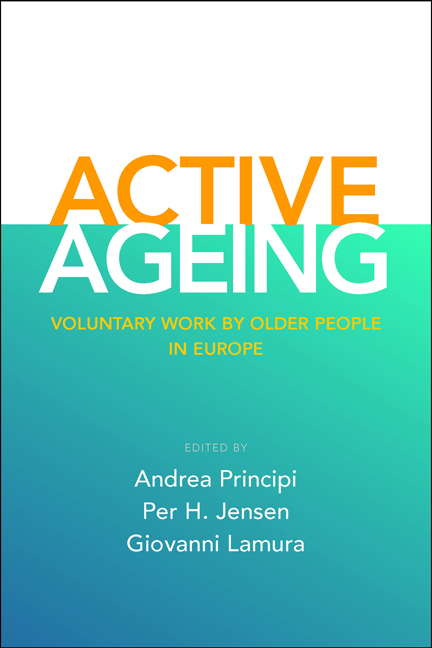Book contents
- Frontmatter
- Contents
- List of tables and figures
- Notes on the contributors
- Acknowledgements
- Foreword
- Part I Realising volunteering by older people in Europe An overarching approach
- Part II Opportunities and restrictions for older volunteers National experiences
- Part III Opportunities and restrictions for older volunteers Case studies in European voluntary organisations
- Part IV Conclusions
- Index
three - Older volunteers in Italy: an underestimated phenomenon?
Published online by Cambridge University Press: 05 March 2022
- Frontmatter
- Contents
- List of tables and figures
- Notes on the contributors
- Acknowledgements
- Foreword
- Part I Realising volunteering by older people in Europe An overarching approach
- Part II Opportunities and restrictions for older volunteers National experiences
- Part III Opportunities and restrictions for older volunteers Case studies in European voluntary organisations
- Part IV Conclusions
- Index
Summary
Introduction
Despite recent changes, the familistic Mediterranean Italian welfare state (Esping-Andersen, 1996; Ferrara, 1996) is still largely anchored in the male breadwinner/female carer family model (Lewis, 1992; Pfau-Effinger, 2005). According to this model and its cultural context, women are expected to have the main responsibility for carrying out homemaking and caring tasks, often on a full-time basis, and particularly in the Central-Southern regions. This explains why female labour force participation rates – as for older workers – are still very low in most Italian regions (although a trend towards higher participation rates can be observed in recent years), whereas the state's role is mainly that of providing not so much in-kind services, but rather care allowances (Bettio and Plantenga, 2004), financial support that is frequently used by households to privately hire migrant care workers (Di Rosa et al, 2012).
The limited extent of state-run or funded care services helps explain why voluntary work in Italy is concentrated in this field. On the whole, however, the voluntary sector in Italy appears to be underdeveloped when compared to other European countries, especially those in the North. This may be explained by the fact that, on the one hand, volunteering in Italy is not felt as a ‘social norm’ (Ascoli and Cnaan, 1997), while on the other, actual volunteering-like activities, particularly in the culture and recreation fields, may not be perceived as such in the eyes of many Italians. Indeed, the dominant profile of volunteering in Italy has often been described as mainly ‘altruistic’ and ‘service-oriented’ (ISTAT, 2006a; Fondazione Roma Terzo Settore, 2010). However, the amount of ‘self-expressive’ volunteering may be underestimated by some of the existing surveys, due to sample biases and cultural social norms, as this form of volunteering is, to some extent, not perceived as such by the common Italian mentality. As a consequence, only about 10 per cent of the population describes itself as being actively engaged in voluntary activities (ISTAT, 2011), which are performed in about 220,000 non-profit institutions, mainly registered as associations, 81 per cent of whose workforce is made of volunteers (ISTAT, 2001a). The total contribution produced by voluntary work has been estimated to reach 0.7 per cent of GDP (gross domestic product), while the whole non-profit sector adds up to over 4 per cent of GDP (CNEL-ISTAT, 2011).
- Type
- Chapter
- Information
- Active AgeingVoluntary Work by Older People in Europe, pp. 47 - 70Publisher: Bristol University PressPrint publication year: 2014

